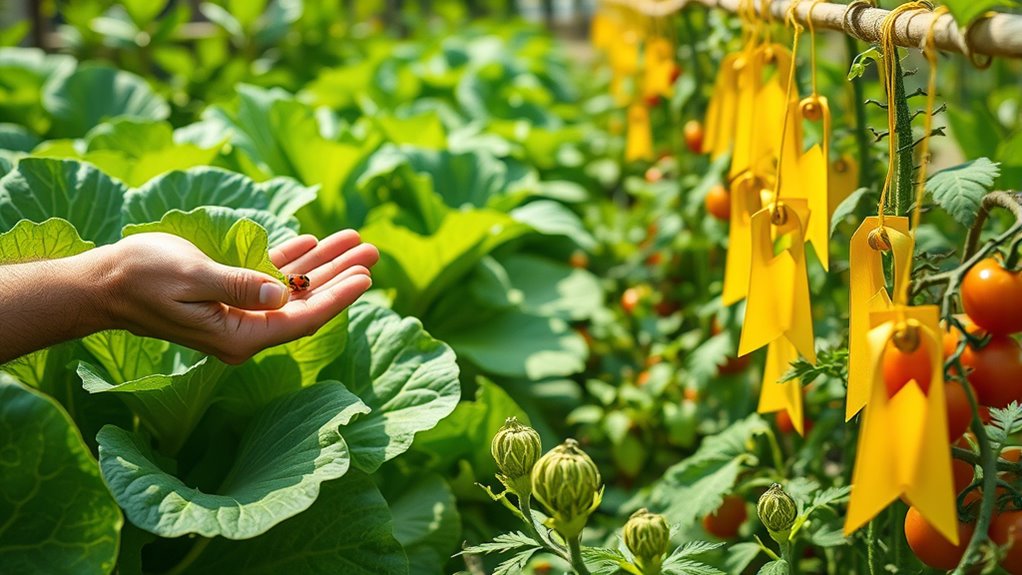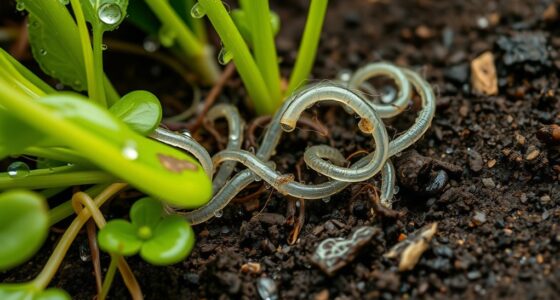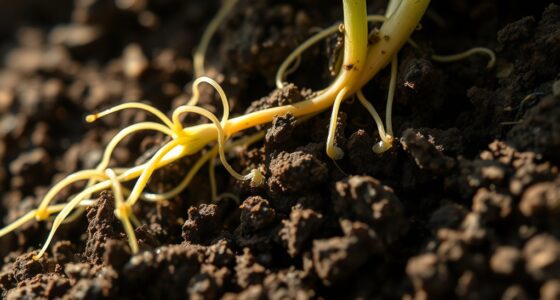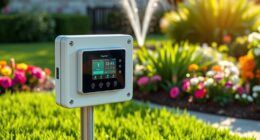Integrated Pest Management (IPM) is a sustainable approach that helps you control pests by combining different strategies instead of just using chemical pesticides. It involves monitoring pests closely, encouraging natural predators, using physical barriers, and applying targeted, eco-friendly treatments only when necessary. This method keeps your garden healthy, reduces chemical use, and promotes a balanced ecosystem. If you continue exploring, you’ll discover how to apply IPM effectively for a thriving garden.
Key Takeaways
- IPM is a holistic pest control approach combining biological, cultural, physical, and chemical methods.
- It emphasizes pest monitoring and identifying issues early to prevent large infestations.
- Biological control uses natural predators or parasites to keep pest populations in balance.
- Physical barriers and environmental modifications help prevent pest entry and reduce reliance on chemicals.
- IPM promotes sustainable gardening by minimizing chemical use and supporting healthy, biodiverse ecosystems.
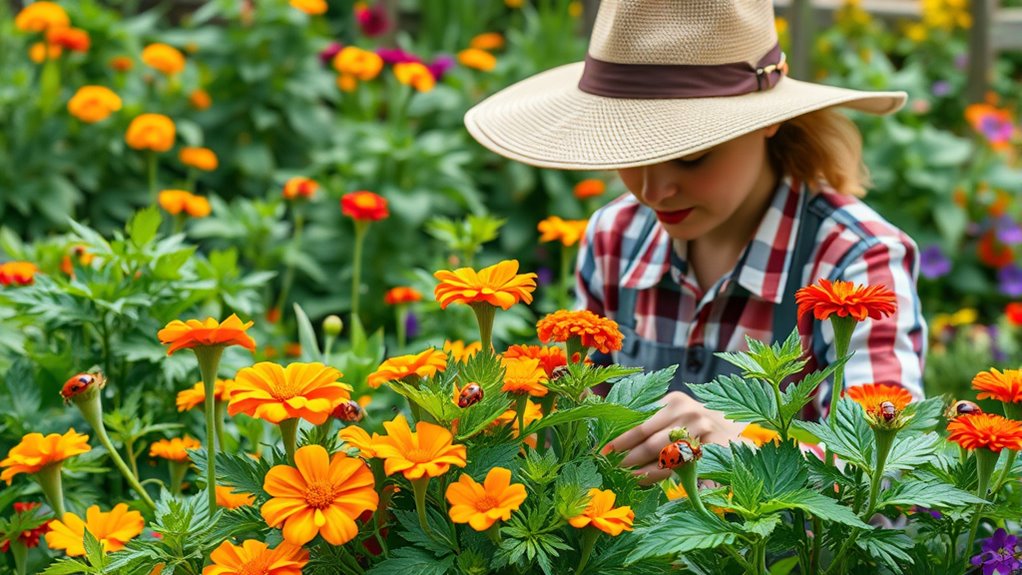
Have you ever wondered how to control pests in your garden without relying solely on chemicals? That’s where integrated pest management, or IPM, comes into play. IPM is a holistic approach that combines different strategies to keep pests under control while minimizing environmental impact. Instead of immediately reaching for pesticides, you use a combination of methods, including biological control and pest monitoring, to manage pests more sustainably.
Biological control is a key component of IPM. It involves introducing or encouraging natural predators, parasites, or pathogens that target specific pests. For example, ladybugs can help control aphids, while parasitic wasps target certain caterpillars. By fostering a balanced ecosystem in your garden, biological control helps keep pest populations in check naturally. It’s a sustainable approach that reduces your reliance on chemical pesticides, which can harm beneficial insects and pollute the environment.
Pest monitoring is equally essential. Regularly inspecting your plants allows you to identify pest problems early before they escalate. You don’t need to wait until you see large infestations; instead, keep an eye out for early signs like chewed leaves, discolored spots, or the pests themselves. Use a simple magnifying glass if needed. With diligent pest monitoring, you can determine whether pest levels are tolerable or if intervention is necessary. This targeted approach prevents unnecessary application of treatments and helps you maintain a healthy, productive garden.
Additionally, understanding specific pest behaviors and the essential oils] that can help repel or manage them can further enhance your IPM efforts. Combining biological control and pest monitoring forms the backbone of an effective IPM strategy. When you notice pests early, you can introduce natural enemies or use physical barriers rather than resorting to chemicals. For example, if you detect a small aphid outbreak, releasing ladybugs or planting companion plants that attract beneficial insects can be enough to control the problem. If monitoring shows pest populations are growing beyond acceptable thresholds, then targeted, environmentally friendly treatments can be used. This stepwise approach optimizes pest control while safeguarding your garden’s health and biodiversity.
In essence, IPM empowers you as a gardener to make informed decisions. It’s about understanding your garden’s ecosystem, monitoring pest activity carefully, and applying control methods only when necessary. Biological control and pest monitoring work together to create a balanced environment, reducing the need for chemical interventions. As you become more familiar with your garden’s unique needs, you’ll find that managing pests becomes more effective, sustainable, and less stressful. With patience and vigilance, you can enjoy a thriving, healthy garden that’s resilient against pests without compromising ecological integrity.
Frequently Asked Questions
How Does IPM Differ From Conventional Pest Control Methods?
You’ll notice IPM differs from conventional pest control because it reduces chemical reliance and pesticide dependence. Instead of spraying pesticides as a first solution, you focus on monitoring pests, using biological controls, and employing cultural practices. This approach minimizes environmental impact and promotes sustainable gardening. With IPM, you target pests precisely, avoiding unnecessary chemical use, which keeps your garden healthier and safer for beneficial insects and pollinators.
Can IPM Completely Eliminate All Garden Pests?
You might think pest eradication is a silver bullet, but it’s unlikely IPM will completely eliminate all garden pests. Instead, it focuses on managing pests sustainably, reducing chemical dependency, and preventing damage. While it’s effective for keeping pests in check, some may still sneak through. Think of it as a balanced approach that minimizes harm and promotes healthy plants, rather than a foolproof solution for total pest removal.
What Are the Initial Costs of Implementing IPM?
When considering the initial costs of implementing IPM, you should think about cost considerations and budget planning. While some practices like monitoring and using natural controls may require minimal investment, others, like introducing beneficial insects or installing barriers, can add to expenses. Overall, IPM can be cost-effective long-term, but you’ll want to evaluate your specific needs and allocate funds accordingly to guarantee successful pest management.
Is IPM Suitable for Organic Gardening?
Think of IPM as a tailored suit—perfectly fitting your organic garden. Yes, it’s suitable for organic gardening because it emphasizes natural methods and minimizes chemical use. Its organic compatibility allows you to use biological controls, cultural practices, and mechanical methods. By integrating these eco-friendly strategies, you can keep pests at bay while nurturing your garden’s health, making IPM an excellent choice for organic enthusiasts.
How Long Does It Take to See Results With IPM?
When you start IPM, you’ll typically see results within a few weeks, but it depends on your pest’s lifecycle and the severity of the infestation. By regularly monitoring your garden with effective techniques, you catch pests early and prevent major damage. Understanding the pest lifecycle helps you time interventions better, speeding up results. Consistent monitoring and timely action guarantee you’ll notice fewer pests and healthier plants faster.
Conclusion
By adopting integrated pest management, you can reduce pesticide use by up to 50%, making your garden safer and healthier. It’s a smart, sustainable approach that balances pest control with environmental care. Remember, a well-maintained garden is less attractive to pests, and using natural methods keeps your plants thriving. So, start implementing IPM today—your garden and the planet will thank you! With consistent effort, you’ll enjoy a vibrant, pest-free garden year-round.
